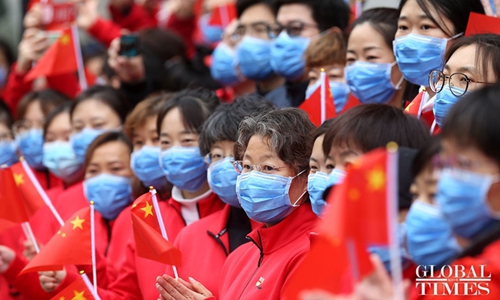If China's data untrustworthy, other countries' questionable too: US expert
By Bai Yunyi Source:Global Times Published: 2020/4/1 22:53:40

Photo: Cui Meng/GT
If China's data cannot be trusted, then global data should also be put under question, he believes.
Huang Yanzhong, a senior fellow for global health at the Council on Foreign Relations of the US, told the Global Times that it's meaningless to hide the true numbers as "policymakers can take correct measures only with accurate data."
If one doubts the credibility of China's data just because asymptomatic patients were not counted, the whole world's numbers are not credible as no single country could test all its population, Huang noted.
The public health expert with the prestigious US think tank said that China's solution to the COVID-19 outbreak is large-scale screening to find all infected people and quarantine or hospitalize them, while keeping up close monitoring of the close contacts.
Based on the Chinese governments' efforts, the screening is thorough and comprehensive. Except for Daegu in South Korea, no other country or region could compare with Wuhan in terms of screening, Huang said.
Huang said that the whole country is aware of the severity of the epidemic, so it is pointless to cover up or play down the number of confirmed cases. "In fact, the decision makers want nothing more than the most accurate and real number, so they can make the right decision; otherwise they cannot handle the pandemic properly," said Huang.
Business Insider, a US media outlet, cited the joint report compiled by China's Center for Disease Control and Prevention, along with the WHO, which revealed that 320,000 tests were performed in the province of Guangdong alone between January 30 and February 16.
It said that although China has changed the way it counted cases several times, this was done transparently. On February 13, China's case count seemed to spike - 15,000 new cases were reported in 24 hours. But the Hubei Health Commission publicly announced that it had started including diagnoses made via CT scans of patients' lungs, rather than just patients with confirmed lab-test results.
That change in the diagnosis method allowed hospitals to identify the patients and isolate them faster, the commission said, according to Reuters. Even though it meant the numbers jumped dramatically, China was forthcoming about this change.
In the US, by contrast, it's much harder to get data and information about the outbreak.
As the number of confirmed US cases started to climb in the last week of February, the Centers for Disease Control and Prevention did not update case numbers regularly on its site. A state-by-state map was only added on March 1, after the number of coronavirus cases had quadrupled over 10 days.
Huang believed the mortality rate in South Korea, about 1 percent, can also prove the authenticity of China's numbers, because it is close to the death rate outside China's Hubei Province. "From this point of view, the possibility for covering up confirmed cases is very slim," said Huang.
As for the category of asymptomatic patients, who came under the spotlight globally, Huang said that it is a statistical problem. China only singled out this group of patients, which cannot be interpreted as covering up data. Plus, China already put the close contacts of the confirmed cases under medical quarantine, so silent infectors are very likely to be among the close contacts, he said.
"It is indeed difficult to find every asymptomatic carrier," Huang said. "However, if China's figures are unreliable, then the figures of all countries in the world are unreliable, because if you want to get an extremely accurate number, every citizen must be tested."
People must undergo both nucleic acid and antibody tests, as some people may have been infected but then recovered. This is obviously not possible for everyone, Huang said.
It does not make much sense to discuss whether a country underreports data or not. The point is whether a country has the ability and willingness to find as many infected people as possible, he said.
According to Huang, the current capacity and scale of detection in the US have greatly improved compared with the initial stage. The country has already developed rapid detection capabilities. However, in most areas, people would consult a family doctor or the relevant health department after showing suspicious symptoms.
After a doctor decides that it is necessary to test, the person will then be tested. "Therefore, taking New Jersey where I live for example, 80 percent of people who received the tests, tested positive for coronavirus infection."